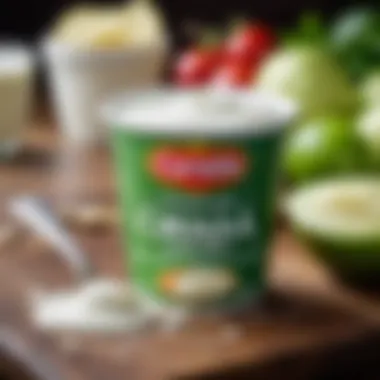Market Trends and Pricing of Sour Cream in Pyaterochka


Актуальные акции и скидки
In the competitive landscape of retail, especially in popular chains like Pyaterochka, promotions and discounts play a crucial role in attracting customers. Sour cream, a widely consumed dairy product in Russia, is often subject to various pricing strategies. Identifying current offers can be vital.
Обзор текущих предложений
Presently, Pyaterochka features multiple discounts on sour cream, catering to different consumer preferences. For instance, several brands are offering "buy one get one free" promotions. This tactic not only incentivizes bulk purchases but also encourages brand loyalty. Common brands like Prostokvashino and Danone are often seen in these promotions, leading to a notable increase in销量.
Additionally, special holiday promotions can influence pricing. During times like New Year or Orthodox Christmas, Pyaterochka tends to showcase discounts on various dairy products, including sour cream. Such promotions are highlighted in the weekly flyers distributed to consumers, making them more visible.
Специальные предложения от популярных брендов
Beyond general discounts, specific brands also launch targeted promotions. For instance, Vashi Produkty often has seasonal discounts, appealing to budget-conscious families. Their sour cream can sometimes be found significantly cheaper than comparable alternatives. This brand has made a reputation for its consistent quality, making it a popular choice among consumers.
Another notable mention is Tetra Pak, which often uses discount strategies to promote their eco-friendly packaging. This appeals to environmentally-aware consumers, enhancing their buying experience. These special offers create a dual opportunity, benefiting both the consumer and the brand.
"In a market where options abound, promotions can decisively sway consumer choices, especially in staple products like sour cream."
Рекомендуемые товары
Given the current market landscape, identifying the recommended products can optimize purchasing decisions. Consumers often seek value without compromising quality.
Топ товаров со скидками
Some of the best-selling sour creams currently include:
- Prostokvashino Sour Cream – Offers a rich taste and is frequently on discount.
- Danone Sour Cream – Known for its smooth texture and reliable quality.
- Vashi Produkty Sour Cream – Often available at a lower price point, appealing to budget shoppers.
These products not only satisfy consumer preferences but also reflect the current trends in pricing.
Товары, которые стоит купить по сниженной цене
Looking for the best deals? Here are products worth considering:
- Tetra Pak Sour Cream – Regular discounts make it an admirable choice for those who value sustainability.
- Syrniki made with Bashkortostan Sour Cream – They are popular among families and often featured in promotional bundles.
Choosing these products during promotional periods ensures savings while maintaining quality. In summary, understanding the market dynamics of sour cream pricing at Pyaterochka reveals significant patterns. Promotions, current offers, and consumer preferences are all intertwined, creating a detailed landscape that informs purchasing decisions.
Prelims to Sour Cream Pricing in Pyaterochka
Pricing of sour cream at Pyaterochka reflects broader market dynamics in Russia's dairy industry. Understanding how these prices are set and what influences them is essential for various stakeholders including consumers, retailers, and producers. The commitment to sourcing local ingredients and maintaining consistent quality is significant to Pyaterochka’s brand identity and customer loyalty.
Consumers benefit from having insights into pricing trends as this knowledge allows them to make informed purchase decisions. Knowledge of sour cream pricing informs family budgets, influencing choices in meal planning and shopping habits. This also contributes to understanding how macroeconomic factors play out in day-to-day food items like sour cream. As sour cream remains a staple in Russian households, examining its pricing can uncover various insights about consumer preferences and demand patterns.
Moreover, in a competitive retail environment, pricing strategies can signal a store’s position within the market. By analyzing the structure and factors of sour cream pricing in Pyaterochka, we can illuminate the complexities within the retail sector, guide consumer choice, and provide retailers with strategic insights for maximized profitability and consumer satisfaction.
Overview of Pyaterochka
Pyaterochka is a well-known retail chain in Russia, operating numerous stores across urban and rural areas. Founded in the late 1990s, it quickly grew in popularity due to its focus on affordability and convenience. The stores stock a wide range of products, including dairy, vegetables, meats, and household items. Location plays a crucial role in customer accessibility, positioning Pyaterochka favorably in the competitive supermarket landscape.
The brand is recognized for its dedication to local suppliers and regional products, which helps to keep prices competitive. Pyaterochka’s strategic approach to stock selection and supplier relationships ensures that the freshness of products such as sour cream is maintained while also addressing price sensitivity among its customer base. The sheer volume of goods that Pyaterochka sells contributes to its ability to offer competitive prices and attract a diverse customer demographic.
Importance of Sour Cream in the Russian Market


Sour cream holds a prominent place in the Russian culinary tradition. It is frequently used in soups, salads, and sauces, making it a key ingredient in many recipes. The cultural significance of sour cream extends beyond flavor; it is involved in family gatherings and traditional celebrations. This ubiquitous nature underscores its importance within the market.
From an economic standpoint, sour cream contributes significantly to the dairy sector in Russia. The production and distribution support numerous jobs, from farming through to retail. As demand for sour cream continues to grow, especially among younger consumers, understanding its market pricing becomes increasingly relevant.
With variations in pricing influenced by production methods and branding, the choices made by consumers can reflect broader economic trends. The interplay between taste, quality, and price defines the sour cream landscape, making it not just a food item but a topic of great interest in market analysis. In summary, sour cream is not only a vital ingredient for numerous Russian dishes but also a key player in the economic and cultural fabric of the country.
Current Pricing of Sour Cream at Pyaterochka
Understanding the current pricing of sour cream at Pyaterochka is essential for anyone interested in navigating the dairy market in Russia. Pyaterochka, as a significant retail chain, influences sour cream prices through its pricing strategies and promotional activities. The standard prices set by Pyaterochka reflect various industry dynamics, including production costs and market trends. Additionally, the pricing at this retailer sets a benchmark that consumers and competitors closely observe.
Standard Pricing
The standard pricing of sour cream at Pyaterochka varies somewhat, depending on several factors, such as brand reputation, packaging size, and product type. For example, a 200g pack of a popular brand may have a price range of 60 to 80 rubles, while larger sizes, like 400g, could range between 100 and 140 rubles. Such pricing reflects the quality and consumer perceptions associated with those brands.
Pricing can also differ based on special ingredients or organic labeling, which may attract a premium price. It is crucial to note that seasonality can impact standard pricing. Certain times of the year, like summer, may see a shift in prices due to changes in production capabilities and demand spikes.
Discounted Pricing and Promotions
Promotions and discounts are a significant part of the pricing strategy at Pyaterochka. The retailer often runs promotional campaigns that lead to substantial savings on sour cream products. For instance, discounts may range from 10% to 30%, especially during seasonal events or holidays. These promotional strategies serve to attract price-sensitive customers and enhance overall sales volume.
Pyaterochka frequently uses loyalty programs that reward customers for optimal purchasing decisions. Engaging in these offers not only benefits consumers looking for value but also allows Pyaterochka to strengthen customer loyalty, adapting to changing consumer behaviors. Ultimately, combining standard pricing with promotional activities enables Pyaterochka to remain a competitive player in the sour cream market.
"Pricing strategies at Pyaterochka not only reflect market dynamics but also adapt based on consumer responses and seasonal trends."
Factors Influencing Sour Cream Prices
Understanding the factors that influence sour cream prices is paramount for both consumers and industry stakeholders. The interplay of various elements helps explain the price points seen in stores like Pyaterochka. This section delves into the significant aspects affecting these prices, including production costs, supply chain dynamics, and market demand trends.
Production Costs
One of the primary drivers of sour cream prices is production costs. These costs encompass all expenses involved in producing sour cream, from raw materials to energy. The ingredients typically include milk and cream, which are paramount for quality. With fluctuations in the cost of dairy farming—affected by feed prices, labor costs, and seasonality—producers experience varying production expenses.
Additionally, investment in technology and equipment can contribute to overall production costs. Modern production techniques may offer efficiency gains but require high initial costs. Producers who embrace these advances may find them beneficial in the long run. However, such investments can affect pricing strategies.
In regions where dairies face higher operational costs, those expenses are often passed on to consumers, leading to higher prices on the shelves.
Supply Chain Dynamics
The supply chain plays a crucial role in determining sour cream prices at Pyaterochka. A complex network exists from farm to grocery shelf, and each stage can impact cost. For instance, transportation costs represent a significant expense in moving goods from farms to processing plants and then to retail locations. Disruptions, such as fuel price increases or logistic challenges, can lead to rising prices for consumers.
Another aspect involves inventory management. Retailers must ensure they maintain adequate stock to meet demand. If demand surpasses supply, prices might rise due to scarcity. Conversely, if surplus inventory exists, promotions or discounts may be enforced to clear stock, reflecting a more dynamic pricing structure.
Market Demand Trends
Changes in consumer preferences greatly influence sour cream pricing. An increase in health-conscious eating has led to higher demand for sour cream products, particularly ones labeled as organic or low-fat. These products generally command higher prices due to perceived value.
Moreover, demographic shifts can also affect demand. Younger consumers may gravitate towards novel flavors or varieties, impacting traditional pricing structures. Special promotions or new product introductions can temporarily shift prices and challenge existing market norms.
"Consumer behavior is key to understanding price fluctuations in the sour cream market."
In summary, production costs, supply chain efficiency, and market demand are integral factors that shape sour cream prices at Pyaterochka. Together, they create a landscape that reflects both consumer tastes and underlying economic realities.
Regional Variations in Pricing
Understanding regional variations in sour cream pricing is crucial for assessing market dynamics within Russia's retail environment. Prices vary significantly between urban and rural areas, influenced by factors such as income levels, demand, and availability. Analyzing these variations provides insights not only into consumer behavior but also into supply chain logistics and pricing strategy employed by retailers like Pyaterochka. By examining these differences, stakeholders can make informed decisions that align with local market conditions.


Urban versus Rural Pricing
Urban and rural pricing shows notable difference in sour cream retail costs. In urban areas, consumers often face higher prices due to increased operational costs for retailers. The proximity to suppliers and stronger competition can lead to more dynamic pricing strategies. For example, a pint of sour cream in Moscow may be priced higher compared to smaller cities like Novgorod. This is not only due to rent but also because urban consumers tend to have higher disposable income, thus boosting the willingness to pay.
Conversely, rural areas might witness lower prices. The lower demand and spending power frequently lead to competitive pricing to attract customers. However, this assumes that logistical factors are managed effectively. Poor transportation access to rural locations can also lead to inconsistent price levels.
Comparative Analysis of Regions
A comparative analysis of regions reveals intriguing insights about sour cream pricing as a reflection of local economies.
- In regions where dairy farming is prevalent like Tatarstan, prices may be lower due to reduced transportation costs and a direct supply of fresher products.
- Conversely, in regions heavily reliant on imports, such as the Siberian areas, prices can soar due to additional shipping fees and longer supply chains.
This regional diversity reveals the importance of local production and distribution channels.
"Regional pricing disparities in sour cream highlight the complexities of supply chain logistics and market responsiveness."
Additionally, observing regional differences can inform marketers about targeted advertising strategies. By recognizing price sensitivity in various locales, promotional offers can be tailored to meet local demand. This might involve placing greater emphasis on discounts in regions where price competition is tougher.
Temporal Changes in Sour Cream Prices
Analyzing temporal changes in sour cream prices is crucial for understanding market dynamics, particularly at Pyaterochka. Over time, prices can fluctuate due to various factors, and recognizing these patterns helps consumers make informed purchasing decisions. These changes often reflect broader economic trends and seasonal variations that affect availability and pricing.
Seasonal Fluctuations
The demand for sour cream is not static; it varies with seasons. For instance, during summer months, when families often enjoy outdoor meals and barbecues, sales of sour cream may increase. These seasonal patterns can lead to temporary price hikes due to heightened demand. Conversely, in winter or off-peak seasons, prices might drop as retailers aim to stimulate sales.
Understanding when these changes occur allows consumers to plan their purchases to capitalize on lower prices.
- Summer: Increased demand, potential price rises.
- Winter: Lower demand, possible discounts to encourage sales.
- Holidays: Special occasions often drive up demand, impacting pricing.
Impact of Economic Factors
Economic factors also significantly influence sour cream prices. Fluctuations in production costs, such as dairy prices, feed prices for livestock, and transportation costs, directly affect the retail prices at Pyaterochka. Additionally, inflation can play a role in how much consumers pay. When the economy is strong, consumers might be willing to pay more, but during recessions, competitive pricing becomes vital to attract budget-conscious shoppers.
- Inflation: May lead to higher prices across the board.
- Supply Chain Disruptions: Any issues here can affect availability and pricing.
- Consumer Spending Power: Strong purchasing power can sustain higher prices.
By monitoring these economic conditions, consumers can better anticipate price changes and make strategic buying decisions.
Consumer Behavior and Purchase Preferences
Understanding consumer behavior and purchase preferences is essential in analyzing sour cream pricing at Pyaterochka. This aspect of the market sheds light on why certain products succeed over others and how consumers decide on their purchases. Acknowledging the specific preferences of shoppers helps in creating strategies that cater to their needs, which can significantly affect pricing and demand.
Brand Preferences
Brand preferences play a crucial role in consumer choices regarding sour cream. Many Russian consumers tend to favor established brands such as "Prostokvashino" or "Danone". These brands often carry a reputation for quality and reliability, which influences buying decisions.
The loyalty of consumers towards certain brands can drive up their prices, as those brands hold a strong market position. This can lead to a price premium over other lesser-known brands that might offer similar products but lack the same recognition. Additionally, brand loyalty can be influenced by advertising, endorsements, and past experiences.
• Consumer trust in brands can create a stable sales ecosystem. • Discounts or loyalty programs often target brand purchase incentives. • A brand's quality perception can justify higher prices.
Packaging and Size Preferences
Packaging and size preferences are also important in the sour cream market. Many consumers opt for packaging that offers convenience and ease of use. For instance, larger containers might appeal to families, while smaller sizes are often preferred by individuals or smaller households.
Moreover, the material and design of packaging can influence buyers. Innovative, user-friendly designs can help products stand out on the shelf, encouraging impulse buys.


Factors contributing to packaging choices include:
- Portability: Easy-to-carry packages attract consumers on-the-go.
- Storage: Tightly sealed packages promise longer shelf lives.
- Environmental Concerns: Eco-friendly packaging is becoming increasingly preferred among environmentally-conscious buyers.
By focusing on these factors, retailers can enhance their product offerings and potentially adjust prices to align with consumer preferences.
Consumer insights on brand and packaging greatly impact pricing strategies, making them invaluable for market success.
Comparative Analysis with Other Retail Outlets
The comparative analysis with other retail outlets provides valuable insight into sour cream pricing at Pyaterochka. Understanding how prices align, differ, or even contradict those found in competing stores enhances comprehension of the market landscape. This comparison is crucial not only for shoppers but also for producers looking to position their products effectively. It reveals underlying pricing strategies and helps identify potential advantages or disadvantages that Pyaterochka may have.
Pricing at Competitor Stores
When examining sour cream prices at competitor stores, it becomes apparent that there are various strategies employed.
- Market Positioning: Some retail chains like Auchan and Magnit may position themselves as budget-friendly alternatives. This is often reflected in lower price points for essential products like sour cream.
- Quality and Brand Variability: Other retailers might emphasize premium brands or organic options, leading to higher prices. For example, bourgeois stores may offer specialty brands that appeal to a niche market willing to pay more for perceived quality.
- Promotional Strategies: Weekly sales and discounts can also attract customers. For instance, Lenta might focus on aggressive sales tactics that temporarily lower prices. This approach encourages consumer traffic and can influence Pyaterochka's pricing flexibility.
Producers and retailers must keep a close watch on these price changes. Understanding competitors' tactics can inform more competitive pricing strategies, ensuring that Pyaterochka remains appealing to its customer base.
Market Share Analysis
Market share analysis reveals how sour cream pricing at Pyaterochka stands in comparison to the overall market, which is a critical metric for any business. With the rise of various retail formats, it is essential to grasp the share of each player in the sour cream category.
- Consumer Preferences: Insights into which stores dominate the market help identify where Pyaterochka stacks up. A significant market share may signify strength, but if the competition siphons off loyal customers, Pyaterochka faces challenges.
- Sales Volume: Additionally, tracking sour cream sales volumes aids in recognizing trends and shifts. If Pyaterochka shows a decline in volume, it raises questions about product availability or pricing strategies.
- Competitive Advantage: Identifying strengths such as location, assortment, and pricing can inform better retention strategies for consumers. This could include targeted promotions or enhancing product variety to compete effectively.
Understanding market dynamics through thorough comparative analysis can improve pricing strategies and market engagement for Pyaterochka, ultimately benefiting consumers seeking better options.
Promotional Strategies at Pyaterochka
Promotional strategies play a significant role in the marketing landscape of Pyaterochka, a well-known retail chain in Russia. These strategies affect sour cream pricing directly and reflect the store's efforts to attract customers while maximizing profitability. Understanding these strategies is essential for consumers and market analysts alike.
Loyalty Programs
In a competitive retail environment, loyalty programs become critical as they incentivize repeat purchases and strengthen customer commitment. Pyaterochka utilizes various loyalty initiatives designed to reward shoppers for their consistent purchases. By participating in these programs, customers can accumulate points for future discounts, receive exclusive promotions, and access targeted offers tailored to their shopping habits.
The benefits of loyalty programs are manifold. First, they can lead to increased spend on sour cream products as customers are more likely to opt for brands available under the loyalty scheme. Second, they provide valuable data to Pyaterochka, allowing them to adjust pricing strategies based on consumer preferences and buying patterns. A noteworthy aspect is the emotional connection that loyalty programs foster. Customers feel valued and recognized, which enhances their shopping experience and encourages them to prioritize Pyaterochka for purchasing sour cream and other dairy products.
Seasonal Promotions
Seasonal promotions are another key component of Pyaterochka’s marketing tactics. These promotions align with festive seasons, holidays, and events, presenting opportunities for significant discounts on sour cream. Common holidays like New Year’s or International Women’s Day see heightened promotional activities, optimizing sales during peak times.
These promotions not only drive up sales volumes but also impact pricing perceptions among consumers. When shoppers see attractive discounts, it enhances their perception of value and can lead to bulk purchasing. Additionally, such promotions often also boost brand awareness, especially if paired with specific limited-time offers on particular products.
"Seasonal promotions can temporarily alter the competitive landscape, driving both foot traffic and online engagement."
Culmination and Future Prospects
Understanding the factors surrounding sour cream prices in Pyaterochka is crucial for various stakeholders. This includes consumers, producers, and retailers alike. The pricing dynamics are influenced by a multitude of elements, including production costs, supply chain efficiency, and consumer behavior. The future of sour cream pricing is likely to be shaped by ongoing economic changes and potential shifts in consumer preferences.
Summary of Findings
The analysis presented in this article highlights several key points regarding sour cream pricing at Pyaterochka. First, there is a notable relationship between production costs and retail pricing. Fluctuations in dairy prices impact overall sour cream prices significantly. Additionally, the competitive landscape of the retail market plays a vital role in determining pricing strategies.
Moreover, consumer preferences were analyzed, revealing a trend towards branded sour cream, which often commands a higher price due to perceived quality. Seasonal promotions and loyalty programs at Pyaterochka also appear to influence purchasing behavior, leading to temporary price reductions during specific times of the year.
Recommendations for Consumers
For consumers seeking to make informed purchasing decisions, awareness of pricing trends is essential. Here are some recommendations:
- Monitor Prices Regularly: Keep an eye on the prices of sour cream at Pyaterochka. This can lead to savings, especially during promotional periods.
- Evaluate Brand Choices: While branded options may seem more expensive, consider the quality and whether it justifies the price in your case.
- Take Advantage of Loyalty Programs: Engaging with the loyalty programs offered can yield discounts and benefits.
- Consider Seasonal Buying: Purchasing sour cream during sales seasons can lead to significant financial savings.



